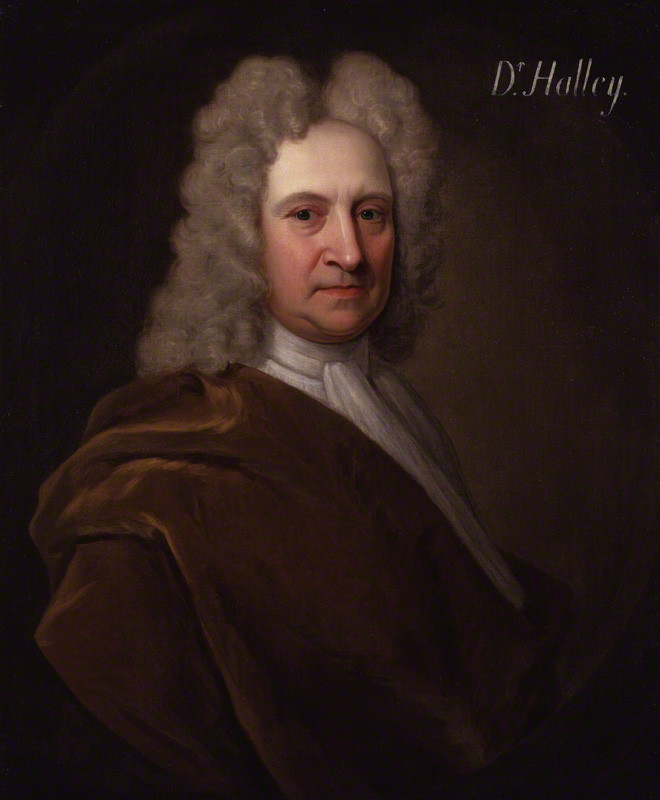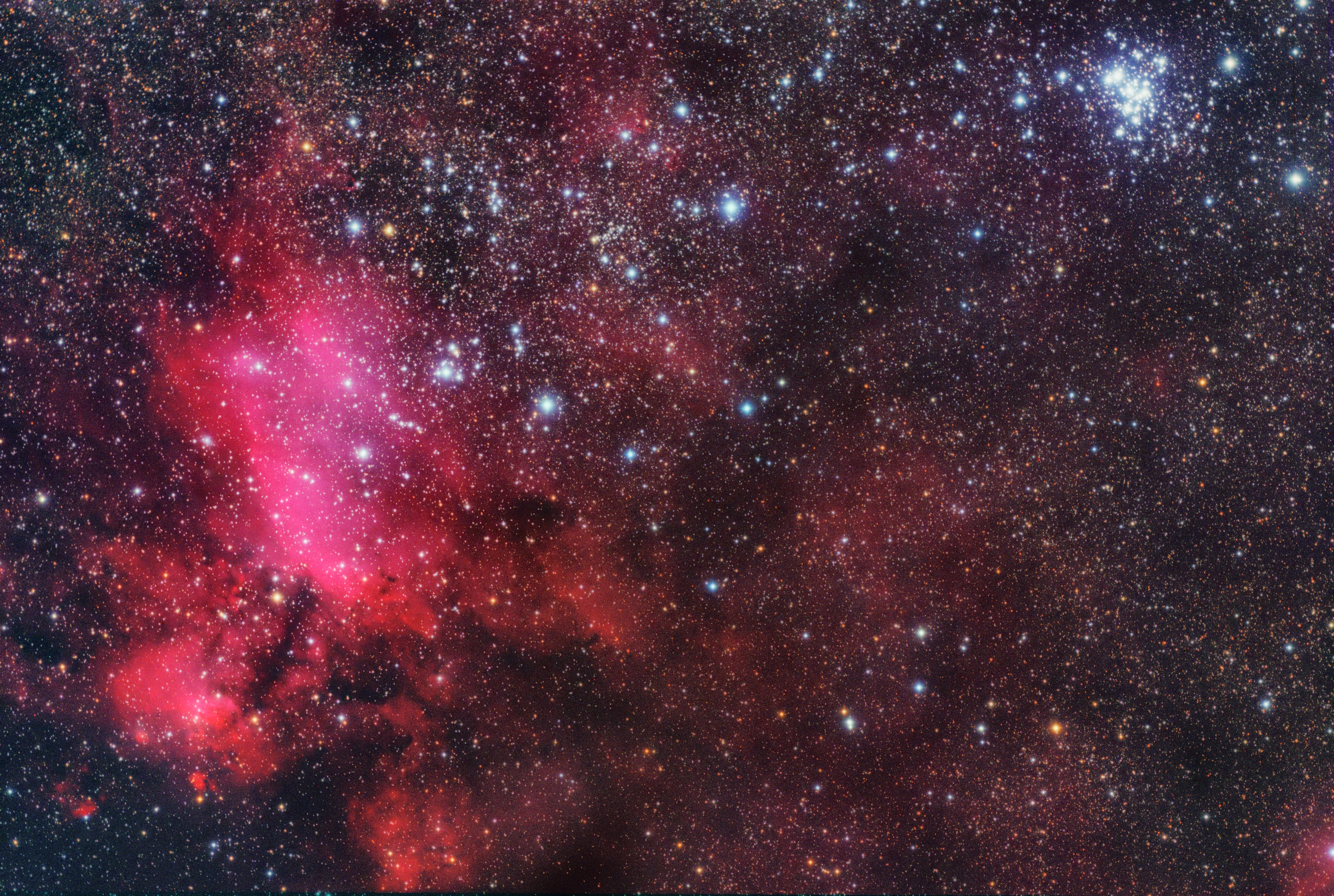|
NGC 6231
NGC 6231 (also known as Caldwell 76) is an open cluster in the southern sky located half a degrees north of Zeta Scorpii. NGC 6231 is part of a swath of young, bluish stars in the constellation Scorpius known as the Scorpius OB1 association. The star Zeta1 (HR 6262) is a member of this association, while its brighter apparent partner, Zeta2 (HR 6271), is only 150 ly from Earth and so is not a member. This cluster is estimated about 2–7 million years old, and is approaching the Solar System at 22 km/s. The cluster and association lie in the neighboring Sagittarius Arm of the Milky Way. Zeta1 Scorpii (spectral type O8 and magnitude 4.71.) is the brightest star in the association, and one of the most radiant stars known in the galaxy. NGC 6231 was used to measure the binary fraction of B-type stars: 52 ± 8%, indicating that B-type stars are commonly found in binary systems, but not as commonly as in O-type stars. NGC 6231 also includes three Wolf-Rayet stars: HD 151932 ... [...More Info...] [...Related Items...] OR: [Wikipedia] [Google] [Baidu] |
New General Catalogue
The ''New General Catalogue of Nebulae and Clusters of Stars'' (abbreviated NGC) is an astronomical catalogue of deep-sky objects compiled by John Louis Emil Dreyer in 1888. The NGC contains 7,840 objects, including galaxies, star clusters and emission nebulae. Dreyer published two supplements to the NGC in 1895 and 1908, known as the ''Index Catalogues'' (abbreviated IC), describing a further 5,386 astronomical objects. Thousands of these objects are best known by their NGC or IC numbers, which remain in widespread use. The NGC expanded and consolidated the cataloguing work of William and Caroline Herschel, and John Herschel's ''General Catalogue of Nebulae and Clusters of Stars''. Objects south of the celestial equator are catalogued somewhat less thoroughly, but many were included based on observation by John Herschel or James Dunlop. The NGC contained multiple errors, but attempts to eliminate them were made by the ''Revised New General Catalogue'' (RNGC) by Jack W. Sulent ... [...More Info...] [...Related Items...] OR: [Wikipedia] [Google] [Baidu] |
Stellar Magnitude
Apparent magnitude () is a measure of the brightness of a star or other astronomical object observed from Earth. An object's apparent magnitude depends on its intrinsic luminosity, its distance from Earth, and any extinction of the object's light caused by interstellar dust along the line of sight to the observer. The word ''magnitude'' in astronomy, unless stated otherwise, usually refers to a celestial object's apparent magnitude. The magnitude scale dates back to the ancient Roman astronomer Claudius Ptolemy, whose star catalog listed stars from 1st magnitude (brightest) to 6th magnitude (dimmest). The modern scale was mathematically defined in a way to closely match this historical system. The scale is reverse logarithmic: the brighter an object is, the lower its magnitude number. A difference of 1.0 in magnitude corresponds to a brightness ratio of \sqrt /math>, or about 2.512. For example, a star of magnitude 2.0 is 2.512 times as bright as a star of magnitude 3.0, ... [...More Info...] [...Related Items...] OR: [Wikipedia] [Google] [Baidu] |
NGC 4755
The Jewel Box (also known as the Kappa Crucis Cluster, NGC 4755, or Caldwell 94) is an open cluster in the constellation Crux, originally discovered by Nicolas Louis de Lacaille in 1751–1752. This cluster was later named the Jewel Box by John Herschel when he described its telescopic appearance as "...a superb piece of fancy jewellery". It is easily visible to the naked eye as a hazy star some 1.0° southeast of the first-magnitude star Mimosa (Beta Crucis). This hazy star was given the Bayer star designation "Kappa Crucis", from which the cluster takes one of its common names. The modern designation Kappa Crucis has been assigned to one of the stars in the base of the A-shaped asterism of the cluster This cluster is one of the youngest known, with an estimated age of 14 million years. It has a total integrated magnitude of 4.2, is located 1.95 kpc. or 6,440 light years from Earth, and contains just over 100 stars. Discovery and observation The Jewel Box as a star c ... [...More Info...] [...Related Items...] OR: [Wikipedia] [Google] [Baidu] |
Abbe Lacaille
Abbé Nicolas-Louis de Lacaille (; 15 March 171321 March 1762), formerly sometimes spelled de la Caille, was a French astronomer and geodesist who named 14 out of the 88 constellations. From 1750 to 1754, he studied the sky at the Cape of Good Hope in present-day South Africa. Lacaille observed over 10,000 stars using just a half-inch refracting telescope. Biography Born at Rumigny in the Ardennes in eastern France, he attended school in Mantes-sur-Seine (now Mantes-la-Jolie). Afterwards, he studied rhetoric and philosophy at the Collège de Lisieux and then theology at the Collège de Navarre. He was left destitute in 1731 by the death of his father, who had held a post in the household of the duchess of Vendôme. However, he was supported in his studies by the Duc de Bourbon, his father's former patron. After he graduated, he did not accept ordination as a priest but took deacon's orders, becoming an Abbé. He concentrated thereafter on science, and, through the patro ... [...More Info...] [...Related Items...] OR: [Wikipedia] [Google] [Baidu] |
Jean-Philippe De Cheseaux
Jean-Philippe Loys de Cheseaux (; 4 May 1718 – 30 November 1751) was a Swiss astronomer. Biography Loys de Cheseaux was born on 4 May 1718 in Lausanne, Vaud, to Paul-Etienne Loys de Cheseaux, a banneret, and Estienne-Judith de Crousaz. His brother was Charles-Louis Loys de Cheseaux. He was educated by his maternal grandfather, the mathematician and philosopher Jean-Pierre de Crousaz, and wrote his first essays, under the title ''Essais de Physique'', in 1735, aged 17. In 1736, Loys de Cheseaux installed an observatory in his father's lands in Cheseaux-sur-Lausanne. He acquired a reputation in Europe as an astronomer with the publication of his ''Traité de la Comète'', in 1744, a treatise on his observations of the comet C/1743 X1 in which he also became one of the first to state, in its modern form, what would later be known as Olbers' paradox (that, if the universe is infinite, the night sky should be bright). After his discovery of C/1743 (along with Dirk Klinkenberg), ... [...More Info...] [...Related Items...] OR: [Wikipedia] [Google] [Baidu] |
Edmond Halley
Edmond (or Edmund) Halley (; – ) was an English astronomer, mathematician and physicist. He was the second Astronomer Royal in Britain, succeeding John Flamsteed in 1720. From an observatory he constructed on Saint Helena in 1676–77, Halley catalogued the southern celestial hemisphere and recorded a transit of Mercury across the Sun. He realised that a similar transit of Venus could be used to determine the distances between Earth, Venus, and the Sun. Upon his return to England, he was made a fellow of the Royal Society, and with the help of King Charles II, was granted a master's degree from Oxford. Halley encouraged and helped fund the publication of Isaac Newton's influential ''Philosophiæ Naturalis Principia Mathematica'' (1687). From observations Halley made in September 1682, he used Newton's laws of motion to compute the periodicity of Halley's Comet in his 1705 ''Synopsis of the Astronomy of Comets''. It was named after him upon its predicted return in 1758, ... [...More Info...] [...Related Items...] OR: [Wikipedia] [Google] [Baidu] |
Palermo
Palermo ( , ; scn, Palermu , locally also or ) is a city in southern Italy, the capital (political), capital of both the autonomous area, autonomous region of Sicily and the Metropolitan City of Palermo, the city's surrounding metropolitan province. The city is noted for its history, culture, architecture and gastronomy, playing an important role throughout much of its existence; it is over 2,700 years old. Palermo is in the northwest of the island of Sicily, by the Gulf of Palermo in the Tyrrhenian Sea. The city was founded in 734 BC by the Phoenicians as ("flower"). Palermo then became a possession of Carthage. Two ancient Greeks, Greek ancient Greek colonization, colonies were established, known collectively as ; the Carthaginians used this name on their coins after the 5th centuryBC. As , the town became part of the Roman Republic and Roman Empire, Empire for over a thousand years. From 831 to 1072 the city was under History of Islam in southern Italy, Arab ru ... [...More Info...] [...Related Items...] OR: [Wikipedia] [Google] [Baidu] |
Giovanni Batista Hodierna
Giovanni Battista Hodierna, also spelled as Odierna (April 13, 1597 – April 6, 1660) was an Italian astronomer at the court of Giulio Tomasi, Duke of Palma (Palma di Montechiaro). He compiled a catalogue of comets and other celestial objects containing some 40 entries, including at least 19 real and verifiable nebulous objects that might be confused with comets. Biography Hodierna was born in Ragusa, Sicily and died in Palma di Montechiaro. While serving as a Roman Catholic priest in Ragusa, he also practised astronomy. In 1654 he published a book entitled '' De systemate orbis cometici, deque admirandis coeli characteribus'' that contained a catalogue of celestial objects. The work anticipated Messier's catalogue, but had little impact. Messier seems not to have known of it. Hodierna was prolific in publication, and his interests spanned many disciplines. In addition to his astronomical observations, he utilized optic microscopes to study insects, publishing on the mu ... [...More Info...] [...Related Items...] OR: [Wikipedia] [Google] [Baidu] |
HD 152408
HD 152408, also known as WR 79a, is a Wolf-Rayet star located in the constellation Scorpius, close to the galactic plane. Its distance is around 2,020 parsecs (6,500 lightyears) away from the Earth. HD 152408 lies in the north of the open cluster NGC 6231, the center of the OB association Scorpius OB1; it is not clear whether it is a part of the association or not. With an apparent magnitude of about 5.77, it is the third brightest Wolf-Rayet star. The other Wolf-Rayet stars that can be seen with the naked eye (although it can only be seen with the naked eye under excellent viewing conditions) are γ2 Velorum (WR 11), θ Muscae (WR 48), WR 22, WR 24 and HD 151932 (WR 78). HD 152408 is about 24 times as massive as the Sun. Like most extremely massive stars, it is losing mass via its stellar wind. The total rate of mass loss is / yr. With an effective temperature of , its bolometric luminosity Luminosity is an absolute measure of radiated electromagnetic power ... [...More Info...] [...Related Items...] OR: [Wikipedia] [Google] [Baidu] |
HD 151932
HD 151932, also known as WR 78, is a Wolf-Rayet star located in the constellation Scorpius, close to the galactic plane. Its distance is around 1,300 parsecs (4,200 lightyears) away from the Earth. Despite being a blue-colored Wolf-Rayet star, it is extremely reddened by interstellar extinction, so its apparent magnitude is brighter for longer-wavelength passbands. HD 151932 lies about 22′ west of the open cluster NGC 6231, the center of the OB association Scorpius OB1; it is not clear whether it is a part of the association or not. With an apparent magnitude of about 6.5, it is one of the few Wolf-Rayet stars that can be seen with the naked eye (although it can only be seen with the naked eye under excellent viewing conditions). Like most extremely massive stars, HD 151932 is losing mass via its stellar wind. The total rate of mass loss is / yr. The multiplicity (i.e., whether the star is a single star or a binary star system) of HD 151932 has not been studied ver ... [...More Info...] [...Related Items...] OR: [Wikipedia] [Google] [Baidu] |








